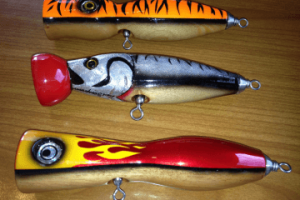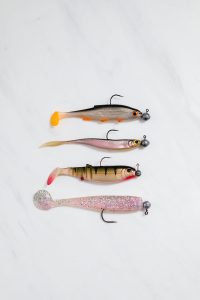Can fishing lures cause cancer? Lead or other carcinogenic chemicals could be discovered in various fishing products, including bait, reels, rods, or weights, rods, and swirls.
Fish bait, or exactly fishing lure, is any material used to attract and catch fish. Today, bait has been produced according to modern lines with lead or plastic.
Because cancer has been the second cause of dead fish in the United States, warning tags like a warning on the lure is a major concern. It is entirely up to you if you want to purchase fishing products. Please read through the article below to understand more about this issue.

Contents
- Is Fishing Lures Toxic?
- Why Do Fishing Lures Have Cancer Warnings?
- Do Fishing Lures Have Lead?
- What Are Fish Lures Made Of?
- Can Fishing Lures Go Bad?
- How Often Should You Change Your Lure?
- Does Fishing Bait Expire?
- Do Fishing Soft Plastics Go Bad?
- Are Soft-Plastic Lures Bad For The Environment?
- Do Soft Plastic Lures Degrade?
- Conclusion
Is Fishing Lures Toxic?
Yes, it can be toxic. Since a lot of naturally occurring substances are also harmful or can cause cancer/birth defects. Some soft-plastic lures contain the same toxic substance, dioxin, found the heavy use of chlorine in PVC and believed to cause cancer.
The manufacturing of artificial lures also includes a class of chemicals called phthalates, a few of which are extremely toxic that could interact with children’s development.
Even though it is unknown what chemicals induce the animals to die, many believe all these chemicals are to blame. All of the above could ultimately lead to the regulation or outright prohibition of soft rubber lures.
One solution to solve the issue is to ensure that your lure is securely attached to your hook and discard used baits securely rather than dumping them through into the water.
Why Do Fishing Lures Have Cancer Warnings?
It’s not unusual to come across many lures with labels warning that such fishing lures could cause cancer or congenital disabilities.
The main reason for cancer cautions on many fishing lures is that some materials cause them to have carcinogens. The carcinogen substance is indeed a cancer-causing substance.
Another reason for the cancer caution is the laws or regulations of each state where the lures are manufactured.
Some states, such as California, have laws requiring the placement of these safety warnings.
Do Fishing Lures Have Lead?
Except for poured lead segments and maybe some moldable plastic, many lure-makers who make fishing lures, certain if commercial or amateur, would not create the individual elements themselves.
Lures are frequently made of lead since it is one heavy metal that can aid in sinking the lure further into the water. If users aren’t interested in using lead lures, you might use baits made of other substances, such as wood or plastic.
These components are equally efficient as lead baits but pose no health risks.
What Are Fish Lures Made Of?
Fishing lures made of one reel and rod, which could be purchased commercially or handcrafted. Inside the angling globe, a hard stainless cord is frequently used to make stainless steel catching fish lures or bait equipment.
They’re usually made of cork, plastic, rubber, metal, or wood and occasionally have feathers and tinsel connected to them to depict the movable parts of the prey, as in fishing flies.
The line could be easily severed in certain fishing situations, especially when fanged fish are present.

Can Fishing Lures Go Bad?
The answer would be no; lures cannot go bad as a consumable food product could. It will not deteriorate or rot.
Artificial bait, on the other hand, could become inadequate and thus less effective, performing worse than it did when you bought it. Synthetic bait, including plastic worms, may last several years if stored properly, but they do not always go bad. Plastic lures, on the other hand, can deteriorate. Toss the artificial bait when it has dried out, managed to lose its shape, and become goopy and crumbly.

How Often Should You Change Your Lure?
When the seasons change, so should your lures. Smaller baits are much more likely to be bitten than larger cousins in winter by patterned marlin, spearfish, or small blue marlin.
Start moving up one size and two in the summer season since there are lots of big fish around. Change your lures to fit the forage in your area.
When your lures aren’t going fishing, and everyone else’s is, switch to something else. This requires a grapevine of friends eager to offer information.
Does Fishing Bait Expire?
All fishing lures will expire at some point. Minnows or worms would die, cut bait rot or Powerbait would become unappealing.
Unfortunately, most good things must have an end, and so does fishing bait. There are, however, methods to prolong the lifespan of the minnows, worms, or cut bait.
Many factors would determine the shelf life of the bait. For example, how much storage you have, the capacity of the holding tank, the temp of the space, water, and so forth. Then there’s the time you devote to bait storage.
Do Fishing Soft Plastics Go Bad?
At the end of each day, throw these worn-out lures in the trash. In addition, most soft plastics would not dissolve if left in water. This implies that if these lures are thrown into one river or lake, they could wait for weeks, if not years.
Some soft plastics have been intended to decompose quickly, but many are not on the market. Since these lures rip and become useless, you can start the pile in your boat. At the finish of each day, you can scoop up your pile and toss all worn-out baits into the trash.
Are Soft-Plastic Lures Bad For The Environment?
Most materials used in making lures are poisonous to some large extent and can cause environmental damage. Fishing baits are unlikely to be the primary cause of ecological pain, but they might be a contributing factor.
There is no doubt that dismissing soft plastic baits on land and in water is polluted and harmful to the environment. Alternatively, place used baits in trash cans or recycling bins.
Bait composting canisters are available at certain boat launches. Moreover, many fishery clubs or retailers also have bait recycling systems.
Do Soft Plastic Lures Degrade?
Fish readily consume soft plastic baits that have been discarded and lost. Some fish, such as bass, could regurgitate lures, but others, such as brook trout, could not.
Because soft plastic baits will not decompose easily in fish and water, they also grow in size over time. In addition, their buildup in fish abdomens can change feeding habits and negatively impact fish growth.
Some soft plastics have been designed to decompose quickly. However, a large percentage of this type in the supply chain is not. Since these lures can rip and become useless, you could start one pile in your boat. At the finish of each day, you can scoop up your pile and toss all worn-out baits into the trash.

Conclusion
Can fishing lures cause cancer? Many believe that some types of bait containing such extremely toxic substances are sold in some stores. What is the truth? The fish died soon after, and in a short time, the fish was rotten; there must be strong toxins in that food.
Notice that people who eat this food are at high risk of poisoning if used in large quantities can lead to death. Therefore, you need to choose the kind of bait that can be expensive but high quality on the market.
If you have any questions, leave your comments below or contact us through social media such as Facebook, and Twitter, and we will reply to you soon. Supporting us to share this post widely. Thanks for reading. fly


